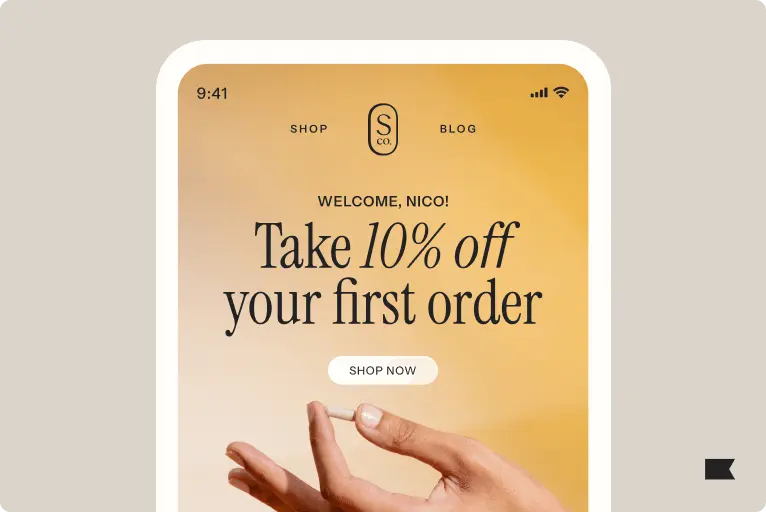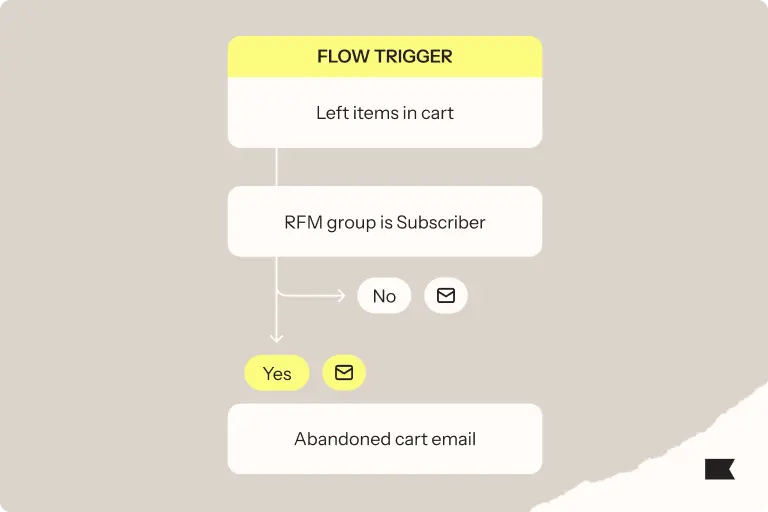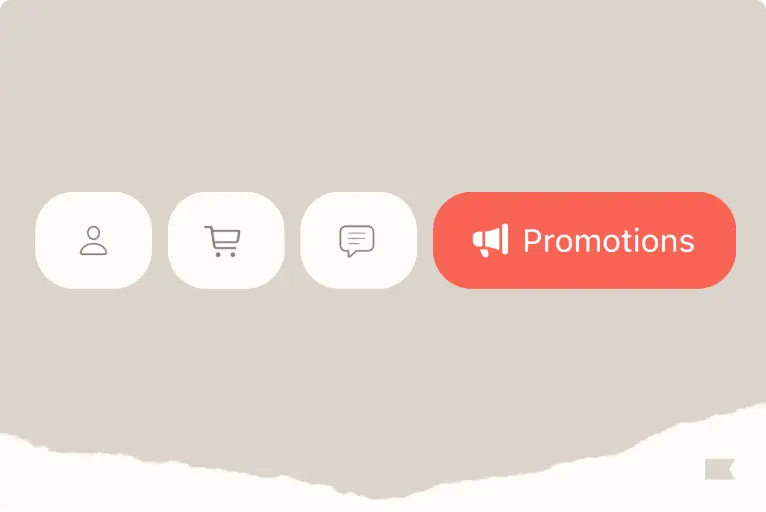How to create an email campaign in 7 steps, with smart strategies and real-life examples
As an owned marketing channel, email puts brands in complete control.
Unlike paid advertising, which puts your marketing efforts at the mercy of another company’s algorithms, email and SMS marketing empower you to build highly personalized, lifelong customer relationships with data that’s already yours.
More important: they work. According to Klaviyo’s marketing mix report, 76.86% of ecommerce businesses place email among their top 3 ROI-generating marketing channels, above paid search, paid social, and SEO.
And while email automation is often in the spotlight due to its ability to generate revenue without much effort beyond set-up, one-time campaigns are also a critical element of success.
For the best results, email campaigns need to be ultra-relevant and highly segmented. Get this right and it can make a huge difference—according to Klaviyo’s latest benchmarks report, the top 10% of industry-leading email campaigns drive 8x more revenue per recipient (RPR) than average brands.
Here’s how to do email campaigns right.
Putting pen to metaphorical paper: 7 steps for creating your email campaign
Before you dive in to the finer details, here’s a high-level list of the 7 email campaign creation steps you need to tackle for each email campaign you launch.
Do you want to convert 5% of newsletter subscribers into customers? Or do you want to increase Black Friday Cyber Monday sales by 10% compared to last year? Knowing your goals will help inform your content and determine what campaign success looks like.
When you do it right, email segmentation empowers your brand to cut through the inbox white noise. Compared to batch and blasting, this approach helps you send the kind of relevant, personalized messages people want to receive—which can increase click rates, placed order rates, and deliverability.
Creating your own email template—or using a pre-built version—not only helps you maintain consistent branding, but also saves time in developing an email design from scratch.
Before you create your email copy, start with your CTA. This should connect to the original goal of your campaign, inspiring readers to take action.
Without a strong subject line, customers may skim over your email, so this is a crucial step. For impactful email copy, use your brand voice guidelines as a starting point for authentic communication, and keep your customer at the heart of your message. Be sure to add images, links, interactive elements, and check that the email displays correctly on all screen sizes.
Before sending, review your email (and then review it again). Schedule your send, and remember to account for customers in different time zones. A/B test variations like subject line, CTA, images, etc. at this stage as well.
Once you send your email campaign, it’s time to monitor analytics like click rate, unsubscribes, RPR, and open rate. If click rates are low, test another offer or review the placement of your CTA. For high unsubscribes, reassess email frequency and if your content is relevant to your customers.
Now that you have your step-by-step list for creating an email campaign, let’s dig in to each specific strategy for bringing your campaign to life.
Step 1: Define your email goals to set your campaign on the right path
Your goals for each email campaign will depend on a number of factors, including your industry vertical and your overall business goals. Here are a few examples of email campaign goals:
- Boosting monthly sales by 20%
- Re-engaging 15% of inactive subscribers
- Increasing click rates by 1%
- Increasing sales of seasonal products by 10% compared to the previous release
These goals will guide the direction of your campaign. If you want to grow your subscriber list, you might launch a referral campaign. If you want to increase email marketing revenue, you might send a campaign promoting a product or sale. If you want to boost brand awareness, you might share educational or mission-related content, or encourage engagement with your social channels.
How email campaign goals work in practice
From St. Patrick’s Day to Mother’s Day, Memorial Day, and BFCM, seasonal emails are a great way to build excitement by informing customers about time-limited deals and discounts. According to Ben Zettler, who helped Shinola see a 27% revenue increase over BFCM through SMS marketing, you need to be intentional about who is seeing your message and who isn’t.
To do that, Zettler helped Shinola lay a personalized BFCM foundation months before the holiday season.
- First, they boosted engagement with segmentation.
- Then, they focused on optimizing flows from high-intent events like cart and check-out abandonment.
- Finally, they were careful to never send to their entire SMS list.
Messages should be personalized and segmented, and that means less batch-and-blast to see higher revenue per recipient.
Step 2: Segment your audience to send relevant content
The batch-and-blast approach to email marketing had its moment, but that was before marketing automation platforms made it easy to split your audience into unique groups.
Batch and blast comes with some undesirable side effects, from decreased engagement to low email deliverability. When you repeatedly send all emails to your entire list, you risk damaging your brand perception as your audience becomes increasingly annoyed with all the irrelevant emails clogging up their inbox.
“I’m always shocked when an ecommerce brand develops an email marketing strategy without utilizing list segmentation,” says Ashley Ismailovski, director of email marketing at SmartSites. “What consumers want now is personalized messages that keep them engaged with their favorite brands and allow them to receive only the most relevant content.”
Segmentation involves splitting your entire email list into smaller groups that share similar characteristics, then delivering content that’s more likely to resonate with each group. Examples of ways to segment your audience include:
- Demographics: location, age, gender, etc.
- Psychographics: interests, lifestyle, values, and beliefs
- Online behavior: purchase type, purchase frequency, purchase history, website browsing, money spent, product page visits, email engagement, reviews, etc.
How email campaign segmentation works in practice
To identify the best kind of messaging for different customers before BFCM, the team at beauty brand Beekman 1802 used Klaviyo’s Peel integration to create segments based on purchase frequency. Segments included frequent shoppers, lapsed one-time buyers, and new subscribers who had never bought any products.
The team tested multiple sends to each segment and monitored how well each campaign performed, well before BFCM. This helped inform the kind of messaging each segment preferred. By the time BFCM rolled around, the marketing team already knew which kinds of emails resonated with each segment—and created promotional emails to match these preferences.
- 74% YoY growth in BFCM email revenue in 2023
- 49% YoY growth in total BFCM ecommerce revenue in 2023
- 38,000 new email sign-ups via on-site pop-up in Q4 2023
Step 3: Choose your template to provide a consistent customer experience
Well-formatted emails that focus on clear communication help quickly convey your message. They also encourage people to take action and click on your CTA.
Good email design takes time—but templates are a great way to replicate components that have worked well in the past.
Most brands create email campaign templates for product launches, newsletters or blog roundups, segmented offers and discounts, and seasonal promotions. At a minimum, each template should contain:
- Email header and preheader
- Your logo
- Navigation bar
- Space for visuals like photos and infographics
- Fonts and colors that match your brand guidelines
- Space for a simple CTA
- Email footer, including an unsubscribe link
You can create your own template, find one online to use as a starting point, or use Klaviyo’s email template library. Filter by type, layout, and season to find the perfect option—then save to your library so you can use them again next time.
How email campaign templates work in practice
Take a look at the template sparkling water brand Aura Bora uses for their flavor of the month emails. After a section breaking down this month’s flavors and their stats, the email continues with a touch of brand storytelling and, finally, a reminder to subscribe to the flavor of the month—a savvy closer that encourages repeat purchases.

Step 4: Create a CTA that inspires action
The CTA is one of the most important elements of an email campaign, so it’s important to understand email CTA best practices. Here’s a quick rundown:
- Defining your CTA before the rest of your campaign copy can help set the tone for everything else.
- “Shop now” CTAs are a popular choice, but there are plenty of other options.
- Aim for no more than 3 CTAs per email.
- Keep the language clear and concise.
- Use a strong color contrast to help them stand out and improve accessibility.
How email campaign CTAs work in practice
This email about Otherland’s limited-edition summer scents uses one CTA above the fold to immediately capture the reader’s attention and encourage them to make a purchase. Toward the end of the email, the reader encounters another CTA suggesting a different action: “explore the seasonal collection.” We love how the content of the email aligns well with those CTAs, with an illustration of each candle in the collection and a short description of each.

Step 5: Craft engaging email content
Your email content consists of:
- Subject line: As the first impression, a strong subject line can make all the difference. AI can help you work out what to include, from personalization to teaser-style copy, emojis, and context. The preview text section is also an important opportunity to capture your reader’s attention.
- Email copy: Keep email copy concise and to the point. Whether you’re writing an end-of-year message, a regular newsletter, or product launch, always consider what value you’re providing to the reader, and maintain a consistent brand voice and tone.
- Visual elements: Design features like brand colors and fonts can help create consistency across multiple emails, while high-quality imagery can complement your copy. Before sending, test your email and make sure it’s readable across multiple devices and inbox providers.
How good content works in practice
This promotional campaign from Red Clay Hot Sauce ends with a recipe that shows exactly how customers can use their spicy everything salt, offering extra value and inspiration to readers. It also includes attractive imagery, brand colors, and a unique CTA to catch customer attention—check, check, and check.

Here, apparel brand Marine Layer takes a more mission-forward approach to email campaign content with their 2023 impact report email. It includes a rundown of the brand’s annual impact and achievements, plus information about their Re-Spun program, designed to keep discarded clothes out of landfills.

Step 6: Understand the best time to send an email campaign
Knowing the best days and times to send your email can help you boost engagement and avoid unsubscribes.
After analyzing data from thousands of email campaigns in 2023, the Klaviyo product analytics team found that Wednesday and Thursday were the best days to send email campaigns. These days had above-average email click rates and placed order rates (although people do seem to order at a high rate on Mondays, too).
A/B testing send times can also help you identify what times correspond with better email performance for your brand, specifically. Whatever send time you decide on, make sure your marketing platform can send emails according to the recipient’s local time zone. This might sometimes involve sending the email on the following day.
If you have an email list of 12,000 subscribers or more, Klaviyo’s Smart Send Time feature can help you maximize your open and click rates and better understand the best email send times for your unique audience.
Step 7: Measure email campaign success and adapt accordingly
Which metrics matter most to your brand depends on the goal of your email marketing strategy, whether it’s revenue-focused (for conversions), brand-focused (for engagement), or both.
According to Klaviyo’s latest benchmarks report, here are averages for some of the most common metrics, with comparisons for the top-performing 10% of brands:
Click rate
- Average: 1.47%
- Top 10%: 5.06%
Placed order rate
- Average: 0.09%
- Top 10%: 0.47%
RPR
- Average: $0.11
- Top 10%: $0.95
Unsubscribe rate
- Average: 0.33%
- Top 10%: 0.09%
Open rate
- Average: 39.74%
- Top 10%: 56.32%
Launching impactful email campaigns with Klaviyo
Creating personalized, impactful email campaigns might sound complex—but Klaviyo puts you in control. Here’s how Klaviyo can help, every step of the way:
- Personalized benchmarks: helps you set specific goals like increasing sales or boosting click rates, plus helps identify and prioritize areas for improvement
- Customer segmentation: makes it easier to divide your audience, with features like Segments AI that help you get the right message to the right customers
- Email templates: 100+ intuitively designed, customizable email templates to choose from, all created with best practices in mind
- Email AI: empowers you to quickly draft eye-catching subject lines and create blocks of copy, before using the drag-and-drop email editor to customize your content
- Smart Send Time: optimizes your email send times based on when your subscribers are most likely to engage
- Reporting and analytics: advanced benchmarks, tracking metrics, and in-depth reporting to track the metrics that matter and give your brand a competitive edge
Related content
- 9 steps to creating an email marketing strategy that’s “thoughtful, intentional, and value-packed”
- 10 email campaign optimization best practices to supercharge your emails
- Aura Bora boosts campaign frequency and grows Klaviyo revenue 59.5% YoY



